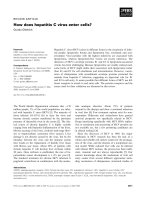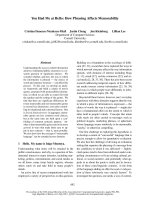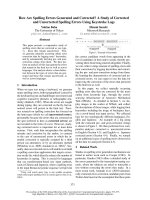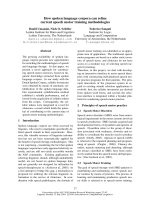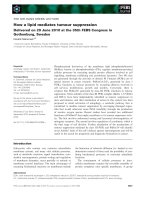báo cáo khoa học: "How can continuing professional development better promote shared decision-making? Perspectives from an international collaboration" pptx
Bạn đang xem bản rút gọn của tài liệu. Xem và tải ngay bản đầy đủ của tài liệu tại đây (229.7 KB, 5 trang )
MEET I N G RE P O R T Open Access
How can continuing professional development
better promote shared decision-making?
Perspectives from an international collaboration
France Légaré
1*
, Hilary Bekker
2
, Sophie Desroches
1
, Renée Drolet
1
, Mary C Politi
3
, Dawn Stacey
4
, Francine Borduas
5
,
Francine M Cheater
6
, Jacques Cornuz
7
, Marie-France Coutu
8
, Nora Ferdjaoui-Moumjid
9
, Frances Griffiths
10
,
Martin Härter
11
, André Jacques
12
, Tanja Krones
13
, Michel Labrecque
1
, Claire Neely
14
, Charo Rodriguez
15
,
Joan Sargeant
16
, Janet S Schuerman
14
and Mark D Sullivan
17
Abstract
Background: Shared decision-making is not widely implemented in healthcare. We aimed to set a research
agenda about pro moting shared decision-making through continuing professional development.
Methods: Thirty-six participants met for two days.
Results: Participants suggested ways to improve an environmental scan that had inventoried 53 shared decision-
making training programs from 14 countries. Their proposed research agenda included reaching an international
consensus on shared decision-making compet encies and creating a framework for accrediting continuing
professional development initiatives in shared decision-making.
Conclusions: Variability in shared decision-making training programs showcases the need for quality assurance
frameworks.
Introduction
Shared decision-making (SDM) is an interactive process
during which patients and practitioners collaborate in
choosing healthcare. SDM is the crux of patient-centered
care [1]. SDM is achieved when both patients and provi-
ders understand the best available evidence on the risks
and benefits of available options and choose a course of
treatment that takes patients’ values and preferences into
account [2-4]. For a number of reasons (fostering the use
of evidence, respecting patient autonomy, etc.), stake-
holders’ preferred mode for clinica l decision making is
shifting from a pater nalistic model to a model consistent
with SDM [5]. A significant proportion of patients prefer
to take an active role in decisions concerning their health,
especially once they understand the benefits of doing so
[6]. For example, patients’ participat ion in decision mak-
ing is associated with favorable health outcomes [7,8].
Moreover, interest in patients’ ac tive participation in
medical education is also increasing [9,10].
Continuing professional development (CPD) is an
important m eans by which health professionals keep
abreast of the latest advances in healthcare [11]. Given the
importance of healthcare professional training to the
impl ementation of SDM in clinical practice, our interna-
tional collaboration sought to increase the knowledge base
of CPD programs and activities that seek to translate SDM
into clinical practice, especially in primary care [12].
As planned in our protocol [12], we organized a two-day
workshop in Quebec City, Canada, in November 2010.
The principal investigator personally invited 35 individuals
and one moderator to attend. Participants came from six
countries (Canada, France, Ge rmany, Switzerland, the
United Kingdom, and the United States) and represented
seven disciplines. There were 14 health services research-
ers [12-26], 11 trainees (five master’s degree students, four
postdoctoral fellows, and two PhD candidates), 5 research
professionals, 3 CPD managers, and 2 representatives of a
large healthcare organization. The objectives of the
* Correspondence:
1
Research Center of Centre Hospitalier Universitaire de Québec, Hospital St-
François D’Assise, Québec City, Québec, Canada
Full list of author information is available at the end of the article
Légaré et al. Implementation Science 2011, 6:68
/>Implementation
Science
© 2011 Légaré et al; licensee BioMed Central Ltd. This is an Open Access article distributed under the terms of the Creative Commons
Attribution License ( which permits unrestricted use, distribution, and reproduction in
any mediu m, provided the original work is properly cited.
workshop were (a) to discuss participants’ knowledge and
perspectives on using CPD activiti es to cause SDM to b e
practiced in primary care, (b) to review the preliminary
results of the environmental scan, (c) to use the prelimin-
ary results to identify knowledge gaps, and (d) to set a
research agenda.
The workshop had two main components (see Addi-
tional File 1). The first component consisted of the follow-
ing elements: two keynote presentations; country
presentations where participants synth esized their coun-
try’s experience with implementing SDM in clinical prac-
tice, especially as concerned training health professionals
in SDM; and the presentation and discussion of the preli-
minary results of an environmental scan. Additional File 2
presents the list of speakers.
The second component of the workshop consisted of
two small group discussions and two plenary sessions. The
workshop concluded with participants drawing on the
group discussions and the previous day’s presentations to
construct a research agenda.
Keynote presentations
In the first keynote presentation, two representatives
from the Ins titute for Clinica l Systems Improvem ent
summarized how to develop a program to train health
professionals in SDM. Comprised of 60 medical groups
representing 9,000 physicians [27], the Institute uses col-
laborative and innovative processes to unite stakeholders
around transforming healthcare systems to deliver
patient-centered, evidence-based care. The Institute’s
objectivesaretoencouragethedeliveryofcarethatis
consistent with the values and preferences of patients
and families, to increase SDM, to augment patients’ satis-
faction with the decision-making process, and to encou-
rage the appropriate use of resources.
In the second keynote presentation, Joan Sargeant of
Dalhousie University, Canada, described how to use multi-
source feedback to assess physicians’ performance and
suggest improvements [28]. Sargeant also discussed the
evaluation of outcomes of educational programs based on
the Kirkpatrick evaluation framework for CPD [29] and
the CPD accreditation standards of the Association of
Faculties of Medicine of Canada [30].
Country presentations
Representatives fro m each country summarized the state
of SDM in t heir country, spoke of challenges to imple-
menting SDM in clinical practice, and reviewed SDM
training activities for healthcare professionals. Representa-
tives from Canada, Germany, the United Kingdom, and
the United States described CPD programs, and represen-
tatives from France and Switzerland described training in
development. Representatives from Canada and Germany
reported on the evaluation of training programs, and
national policy or laws concerning SDM were presented
for France, Germany, Sw itzerland, the United Kingdom,
and the United States. One example of a policy was the
National Health Service (NH S) of the Uni ted Kingdom’s
recent stipulation that SDM would become the norm–the
“No decision about me without me” campaign [31]. The
NHS will also pay providers for their performance, so that
payment reflects outcomes, not just activity, and incenti-
vizes medical staff to provide better care. Another policy
example was France’s 2002 law to protect pati ents’ rights
to informat ion and hold physicians accountable for fully
informing their patients so that individuals can make their
own health decisions, based on information and advice
supplied by their healthcare provider.
Representatives of Ca nada, Germany, Switzerland, and
the United States explained particularities regarding
SDM in their healthcare systems. In the United King-
dom , for example, phys icians deliver care based on evi-
dence of effectiveness, including cost effectiveness, while
in Switzerland, the pharmaceutical industry wields sub-
stantial influence at all levels. Some representatives
spoke of barri ers to the practice of SD M: In the United
States, implementing SDM is made mo re difficult by
the fact that healthcare is delivered by independent
groups. Participants also reported on the implementa-
tion of dec ision aids, on preven tion and health-promo-
tion m easures, and on current research initiatives for
developing and implementing SDM. Participant s
reported more training activities in SDM for health pro-
fessionals since 2007 [32-36] and the appearance of
SDM on the policy agenda of mo re countries (e.g.,
Switzerland).
Preliminary results of the environmental scan
Our aim for the meeting w as to present the preliminary
results of the scan and to explore how to improve and
comp lete this part of our protocol [12]. Briefly, we relied
on three m ain sources of data: (1) members of our team
and their networks, (2) orga nizations and individuals
involved in training healthcare professionals, and (3) sys-
tematic reviews in SDM. We sought out any CPD activity
or CPD program (i.e., set of activities), published or
unpublished, in whatever language, that targeted SDM.
Because our search strategy favored sensitivity over specifi-
city, we considered all SDM training programs, including
those in clinical settings other than primary care. We also
included stand-alone activities when the full program
material was not available to us. Once we had identified
the programs, reviewers extracted each program’smain
characteristics: the program name, the nature of the mate-
rial available and extracted, author contact information,
the creation or publication date, the country of origin, and
the languages in which the program was available. We
also extracted information about the programs’
Légaré et al. Implementation Science 2011, 6:68
/>Page 2 of 5
educational features: their conceptual underpinnings; the
rationale for developing the program; the sources that
informed the program; the healthcare professionals tar-
geted; the clinical context; the program’s objectives and
duration; its components and activities (e.g.,smallgroup
discussion, case study, role play, simulation); essential ele-
ments of SDM covered by the program [37]; and informa-
tion about how the program was assessed, including the
levels of assessment (i.e., participants’ reaction, their
degree of learning, changes in their behavior, and changes
in patient outcomes) [29].
At the group meeting, the team explained the data-
extraction process and prese nted its findings: de tailed
info rmation about 53 program s from 14 countries, pub-
lished in 9 languages. Because six programs were identi-
fied late, the team only extracted the data from 47
programs. Of these, 34 programs targeted licensed
health professionals and were retained as CPD pro-
grams. The clients of those programs were mostly physi-
cians (n = 34) and/or nurses (n = 13). Most programs
mentioned primary care (n = 3 7). There was consider-
able heterogeneity in the programs’ duration (three
hours or less to more than three days) and in their
teaching methods, which included large group sessions
(n = 32), small group sessions (n = 25), auto-tutorials
(n = 15), the dissemination of printed educational mate-
rial (n = 1 6), audit and feedback (n = 13), case discus-
sions (n = 26), simulations (n = 23), and self-evaluations
(n = 12). More programs took place in c ancer (n = 7)
than in any other clinical area, but cardiovascular dis-
eases, diabetes, chronic pain, prenatal screening, and
other areas were represented as well. Most programs
covered the nine essential elements of SDM identified in
the integrated SDM model developed by Makoul and
Clayman (2006) . We also discussed an importa nt limita-
tion of our scan; namely, that we included SDM training
programs and stand-alone activities independent of the
formats in which they were availab le to us (although we
asked authors for all materials used in their programs,
we did not always obtain it). This meant that w e
extracted d ata from diverse formats (e.g.,aPowerPoint
presentation, a class syllabus, trainer and trainee man-
uals, a DVD, an auto-tutorial), which made it difficult to
compare programs, sin ce the information contained in a
PowerPoint presentation, for example, is not as exten-
sive as that contained in a trainer’s manual. We speci-
fied to workshop participants that each program had
only been extracted by one person and that we had not
assessed the programs’ quality but that we intended to
use workshop participants’ feedback to improve the
scanning process after the workshop. We also men-
tioned that in future work of this genre, we intended to
solicit t he feedback of patient representatives as well as
that of academics and managers.
Group discussion
We held two small group discussions. For each one, we
divided the participants into four gro ups of eight people
from diverse backgrounds. In each group, one person took
detailed notes and a second reported back during the
plenary sessions. Additional File 3 details the discussion
questions and their main outcomes. Brie fly, participants
requested a detailed list of the SDM-CPD programs cov-
ered by the scan, as well as a list of programs that had
been excluded, together with the reasons for their exclu-
sion, with a view to verifying whether programs were miss-
ing. They suggested ways to improve reporting (e.g.,
scoring programs’ success at identifying success factors
and best practices, such as the most effective time frames).
They found that the SDM-CPD programs identified in the
scan showed great variety and suggested pursuing the
search for programs or performing a systematic review
instead of an environmental scan.Theyalsosuggested
extracting more information about the programs, such as
the type of conceptual model used (an SDM model or an
educational model); stating whether the program hailed
from a unit devoted to S DM or patient participation or a
similar topic, or whether it came under the umbrella of a
more generic CPD institution; and specifying the types of
learning activities practiced (oriented around skills, atti-
tudes, or knowledge) and each program’s core objectives.
They also asked that the programs be appraised in light of
accreditation standards and suggested asking the program
developers to validate the data extracted from their pro-
gram (member checking). They suggested performing sub-
group analysis (based on country or clinical area, for
example) or focusing solely on postlicensure programs
(i.e.,CPD).
With regard to the research agenda, citing the Interna-
tional Patient Decision Aid Standards research group
[38-41], participants suggested building international
consensus on a core set of competencies for SDM; these
competencies, together with CPD accreditation stan-
dard s, coul d then be drawn upon to dev elop certification
criteria for SDM-CPD programs.
Workshop evaluation
At the end of the workshop, we collected 18 evaluation
sheets. The mean scores for the 10 items (range of 1 = not
at all to 5 = definitively) ranged from 4.3 (for “Were the
presentations scientifically balanced?”)to4.8(for“Were
the discussion sessions useful?” and “Did the speakers and
moderator encourage the audience’s involvement?”). Parti-
cipants also identified weaknesses, proposed improve-
ments, and suggested next steps (see Additional File 4).
Conclusion
To the best of our knowledge, this meeting was the first
to discuss an inventory of SDM-CPD programs across
Légaré et al. Implementation Science 2011, 6:68
/>Page 3 of 5
health professions and co untries and the first to reach
consensus on a detailed research agenda. Our next step
will be to finalize the environmental scan based on parti-
cipants’ feedback. We wil l also work with a larger pool of
stakeholders to (a) explore the feasibility and acceptabil-
ity of participants’ suggestion to establish an international
consensus on core SDM competen cies for SDM-CPD
programs, (b) seek consensus on ways to evaluate CPD
interventions, (c) create an evaluation framework based
on accreditation standards, and (d) construct a grid or
checklist for accrediting SDM-CPD programs based on
the framework mentioned. Finally, we will consider
applying for grants to develop and pilot SDM-CPD pro-
grams across healthcare professions and countries.
Additional material
Additional file 1: Appendix 1. Workshop Agenda
Additional file 2: Appendix 2. List of Speakers and Participants
Additional file 3: Appendix 3. Questions and Answers for the Small
Group Discussions
Additional file 4: Appendix 4. Workshop Evaluation
Acknowledgements
This study is funded by a catalyst grant in primary and community-based
healthcare from the Canadian Institutes of Health Research (CIHR; 2010-2011;
grant # 247587-200910PCH-PCH-212366-I006-9115-TIBAA). FL holds a Canada
Research Chair in Implementation of Shared decision-making in Primary
Healthcare. SD is a Junior 1 Research Scholar from the Fonds de la
recherche en santé du Québec. We thank our research assistants for
participating in the workshop, especially Adriana Freitas for the
environmental scan and the organization of the workshop. We also thank
the graduate students who extracted the data: Geneviève Malboeuf,
Catherine Nadeau, and Kiyand Lawrence Ndoh. Jennifer Petrela edited this
manuscript. The authors declare that they have no personal financial
interests. However, FL, SD, DS, MFC, MH, TK, ML, CN, JSS, and MS are
involved in elaborating and/or studying SDM training programs, including
CPD programs.
Author details
1
Research Center of Centre Hospitalier Universitaire de Québec, Hospital St-
François D’Assise, Québec City, Québec, Canada.
2
Leeds Institute of Health
Sciences, School of Medicine, University of Leeds, Leeds, UK.
3
Department of
Surgery, Division of Public Health Sciences, Washington University in St Louis
School of Medicine, St. Louis, MO, USA.
4
School of Nursing, University of
Ottawa, Ottawa, Ontario, Canada.
5
Continuing Professional Development
Office, Faculty of Medicine, Université Laval, Québec City, Québec, Canada.
6
Institute for Applied Health Research, Glasgow Caledonian University,
Glasgow, UK.
7
Department of Community Medicine, Centre Hospitalier
Universitaire du Vaudois, Lausanne, Switzerland.
8
Centre for Action in Work
Disability Prevention and Rehabilitation, School of Rehabilitation, Université
de Sherbrooke, Longueuil, Québec, Canada.
9
Lyon 1 University, GATE-LSE
(UMR 5824 CNRS), Lyon, France.
10
Health Sciences Research Institute,
University of Warwick, Coventry, UK.
11
Institute and Policlinic for Medical
Psychology, Center for Psychosocial Medicine, University Medical Center
Eppendorf, Hamburg, Germany.
12
Practice Enhancement Division, Collège
des médecins du Québec, Montreal, Québec, Canada.
13
Institute of
Biomedical Ethics, University of Zurich, Zurich, Switzerland.
14
Institute for
Clinical Systems Improvement (ICSI), Bloomington, MN, USA.
15
Department
of Family Medicine, McGill University, Montreal, Québec, Canada.
16
Continuing Medical Education, Faculty of Medicine, Dalhousie University,
Halifax, Nova Scotia, Canada.
17
Department of Psychiatry and Behavioral
Sciences, University of Washington, Seattle, WA, USA.
Authors’ contributions
All authors have made substantial contributions to the conception and
design of this study and to the acquisition of data for the environmental
scan. All authors attended the workshop. FL and RD drafted the manuscript.
All authors revised it critically for important intellectual content and all
approved the final version submitted.
Competing interests
The authors declare that they have no competing interests.
Received: 11 January 2011 Accepted: 5 July 2011 Published: 5 July 2011
References
1. Weston WW: Informed and shared decision-making: the crux of patient
centred care. CMAJ 2001, 165(4):438-440.
2. Charles C, Gafni A, Whelan T: Shared decision-making in the medical
encounter: what does it mean? (or it takes at least two to tango). Soc Sci
Med 1997, 44(5):681-692.
3. Elwyn G, Edwards A, Gwyn R, Grol R: Towards a feasible model for shared
decision-making: focus group study with general practice registrars. BMJ
1999, 319(7212):753-756.
4. Towle A, Godolphin W: Framework for teaching and learning informed
shared decision-making. BMJ 1999, 319(7212):766-771.
5. Kon AA: The shared decision-making continuum. JAMA 2010,
304(8):903-904.
6. Kiesler DJ, Auerbach SM: Optimal matches of patient preferences for
information, decision-making and interpersonal behavior: evidence,
models and interventions. Patient Educ Couns 2006, 61(3):319-341.
7. Carlsen B, Aakvik A: Patient involvement in clinical decision making: the
effect of GP attitude on patient satisfaction. Health Expect 2006,
9(2):148-157.
8. Hack TF, Degner LF, Watson P, Sinha L: Do patients benefit from
participating in medical decision making? Longitudinal follow-up of
women with breast cancer. Psychooncology 2006, 15(1):9-19.
9. Jha V, Quinton ND, Bekker HL, Roberts TE: What educators and students
really think about using patients as teachers in medical education: a
qualitative study. Med Educ 2009, 43(5):449-456.
10. Jha V, Quinton ND, Bekker HL, Roberts TE: Strategies and interventions for
the involvement of real patients in medical education: a systematic
review. Med Educ 2009, 43(1):10-20.
11. Redesigning Continuing Education in the Health Professions. Edited by:
Press TNA. Washington, D.C.: IOMC (Institute of Medicine); 2010:.
12. Legare F, Bekker H, Desroches S, Politi M, Stacey D, Borduas F, Cheater FM,
Cornuz J, Coutu MF, Donner-Banzhoff N, et al: Effective continuing
professional development for translating shared decision-making in
primary care: A study protocol. Implement Sci 2010, 5:83.
13. Bekker HL, Hewison J, Thornton JG: Understanding why decision aids
work: linking process with outcome. Patient Educ Couns 2003,
50(3):323-329.
14. Cheater FM, Hearnshaw H, Baker R, Keane M: Can a facilitated programme
promote effective multidisciplinary audit in secondary care teams? An
exploratory trial. Int J Nurs Stud 2005, 42(7):779-791.
15. Cornuz J, Junod N, Pasche O, Guessous I: [Cancer
screening in clinical
practice: the value of shared decision-making]. Rev Med Suisse 2010,
6(256):1410-1414.
16. Coutu MF, Durand MJ, Baril R, Labrecque ME, Ngomo S, Cote D, Rouleau A:
A review of assessment tools of illness representations: are these
adapted for a work disability prevention context? J Occup Rehabil 2008,
18(4):347-361.
17. Desroches S, Gagnon MP, Tapp S, Legare F: Implementing shared
decision-making in nutrition clinical practice: a theory-based approach
and feasibility study. Implement Sci 2008, 3:48.
18. Griffiths F: Complexity science and its relevance for primary health care
research. Ann Fam Med 2007, 5(4):377-378.
19. Harter M, Simon D: Shared decision-making in diverse health care
systems–translating research into practice. Patient Educ Couns 2008,
73(3):399-401.
Légaré et al. Implementation Science 2011, 6:68
/>Page 4 of 5
20. Krones T, Keller H, Sonnichsen A, Sadowski EM, Baum E, Wegscheider K,
Rochon J, Donner-Banzhoff N: Absolute cardiovascular disease risk and
shared decision-making in primary care: a randomized controlled trial.
Ann Fam Med 2008, 6(3):218-227.
21. Labrecque M, Lafortune V, Lajeunesse J, Lambert-Perrault AM, Manrique H,
Blais J, Legare F: Do continuing medical education articles foster shared
decision-making? J Contin Educ Health Prof 2010, 30(1):44-50.
22. Politi MC, Street RL: The importance of communication in collaborative
decision making: facilitating shared mind and the management of
uncertainty. J Eval Clin Pract 2010, [epub ahead of print]
23. Rodriguez C, Pozzebon M: The implementation evaluation of primary
care groups of practice: a focus on organizational identity. BMC Fam
Pract 2010, 11:15.
24. Stacey D, Legare F, Pouliot S, Kryworuchko J, Dunn S: Shared decision-
making models to inform an interprofessional perspective on decision
making: a theory analysis. Patient Educ Couns 2010, 80(2):164-172.
25. Sullivan MD, Leigh J, Gaster B: Brief report: Training internists in shared
decision-making about chronic opioid treatment for noncancer pain.
J Gen Intern Med 2006, 21(4):360-362.
26. Moumjid N, Gafni A, Bremond A, Carrere MO: Shared decision-making in
the medical encounter: are we all talking about the same thing? Med
Decis Making 2007, 27(5):539-546.
27. Institute for Clinical Systems Improvement: Institute for Clinical Systems
Improvement 2009 Annual Report. Delivering On The Promise.
Bloomington, MN: Institute for Clinical Systems Improvement; 2010.
28. Sargeant J, Mann K, Sinclair D, van der Vleuten C, Metsemakers J:
Challenges in multisource feedback: intended and unintended
outcomes. Med Educ 2007, 41(6):583-591.
29. Kirkpatrick DL: Evaluating training programs: the four levels San Francisco:
Berrett-Koehler edition: Berrett-Koehler Publishers Inc., San Francisco,
California; 1994.
30. Accreditation Standards. [ />31. Department of Health: Equity and Excellence: Liberating the NHS. White
Paper NHS 2010, 57.
32. Evans R, Edwards A, Coulter A, Elwyn G: Prominent strategy but rare in
practice: shared decision-making and patient decision support
technologies in the UK. Z Arztl Fortbild Qualitatssich 2007, 101(4):247-253.
33. Holmes-Rovner M, Gruman J, Rovner DR: Shared decision-making in the
US–research & development outpaces delivery. Z Arztl Fortbild
Qualitatssich 2007, 101(4):254-258.
34. Legare F, Stacey D, Forest PG: Shared decision-making in Canada: update,
challenges and where next! Z Arztl Fortbild Qualitatssich 2007,
101(4):213-221.
35. Loh A, Simon D, Bieber C, Eich W, Harter M: Patient and citizen
participation in German health care–
current state and future
perspectives. Z Arztl Fortbild Qualitatssich 2007, 101(4):229-235.
36. Moumjid N, Bremond A, Mignotte H, Faure C, Meunier A, Carrere MO:
Shared decision-making in the physician-patient encounter in France: a
general overview. Z Arztl Fortbild Qualitatssich 2007, 101(4):223-228.
37. Makoul G, Clayman ML: An integrative model of shared decision-making
in medical encounters. Patient Educ Couns 2006, 60(3):301-312.
38. Elwyn G, O’ Connor A, Stacey D, Volk R, Edwards A, Coulter A, Thomson R,
Barratt A, Barry M, Bernstein S, et al: Developing a quality criteria
framework for patient decision aids: online international Delphi
consensus process. BMJ 2006, 333(7565):417.
39. Elwyn G, O’ Connor AM, Bennett C, Newcombe RG, Politi M, Durand MA,
Drake E, Joseph-Williams N, Khangura S, Saarimaki A, et al: Assessing the
quality of decision support technologies using the International Patient
Decision Aid Standards instrument (IPDASi). PLoS One 2009, 4(3):e4705.
40. O’Connor AM, Bennett C, Stacey D, Barry MJ, Col NF, Eden KB, Entwistle V,
Fiset V, Holmes-Rovner M, Khangura S, et al: Do patient decision aids meet
effectiveness criteria of the international patient decision aid standards
collaboration? A systematic review and meta-analysis. Med Decis Making
2007, 27(5):554-574.
41. O’Connor AM, Bennett CL, Stacey D, Barry M, Col NF, Eden KB, Entwistle VA,
Fiset V, Holmes-Rovner M, Khangura S, et al: Decision aids for people
facing health treatment or screening decisions. Cochrane Database Syst
Rev 2009, , 3: CD001431.
doi:10.1186/1748-5908-6-68
Cite this article as: Légaré et al.: How can continuing professional
development better promote shared decision-making? Perspectives
from an international collaboration. Implementation Science 2011 6:68.
Submit your next manuscript to BioMed Central
and take full advantage of:
• Convenient online submission
• Thorough peer review
• No space constraints or color figure charges
• Immediate publication on acceptance
• Inclusion in PubMed, CAS, Scopus and Google Scholar
• Research which is freely available for redistribution
Submit your manuscript at
www.biomedcentral.com/submit
Légaré et al. Implementation Science 2011, 6:68
/>Page 5 of 5



